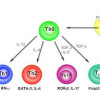Evidence for a shift from a type I lymphocyte pattern with HIV disease progression. Hemophilia Growth and Development Study
Abstract
Whether a shift from a type I (cell mediated) immune profile occurs with progressive HIV-related immune dysfunction is a matter of heated debate.
We analyzed data for 333 HIV antibody-positive (HIV+) and -negative (HIV-) hemophilic children/adolescents, to examine whether the relationships among immunologic parameters and vaccine-related serology supported a shift with advancing HIV infection.… Read more



